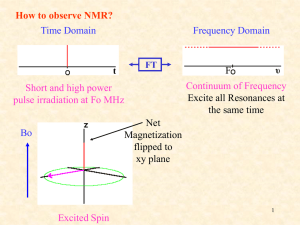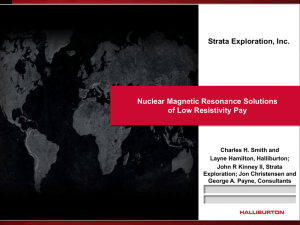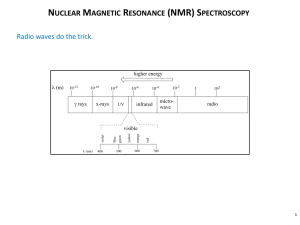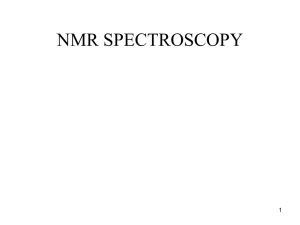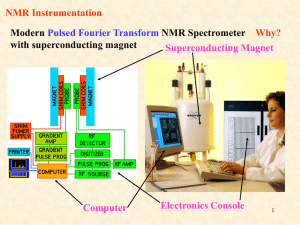T. Takahashi
advertisement
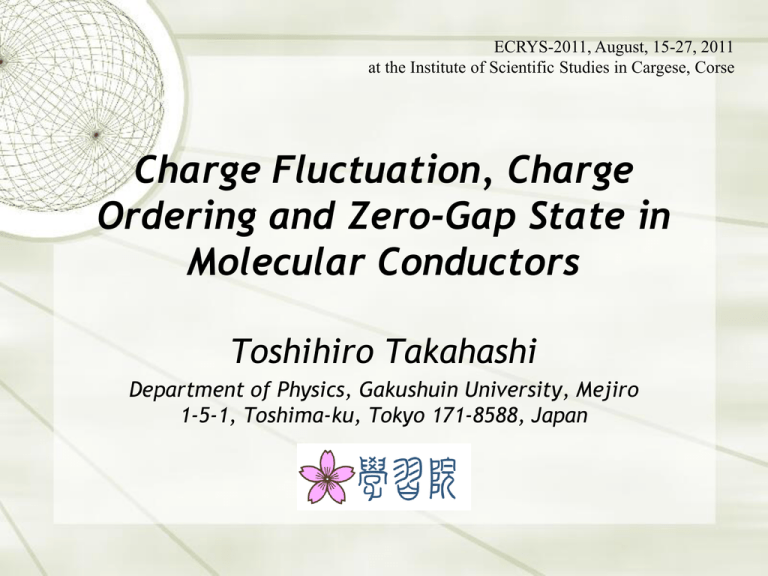
ECRYS-2011, August, 15-27, 2011 at the Institute of Scientific Studies in Cargese, Corse Charge Fluctuation, Charge Ordering and Zero-Gap State in Molecular Conductors Toshihiro Takahashi Department of Physics, Gakushuin University, Mejiro 1-5-1, Toshima-ku, Tokyo 171-8588, Japan 3 keywords: Charge Fluctuation Charge Ordering Zero-Gap State 三題噺 “San-dai-banashi” A style of Japanese traditional comic story, “rakugo”. Three keywords are given independently by the audience. The storyteller, “rakugo-ka”, makes ad lib a consistent comic story using all the keywords. Outline Introduction to NMR technique to probe charge degree of freedom Charge fluctuation and charge ordering in θ-phase BEDT-TTF salts Charge disproportionation in the zero-gap state of α-BEDT-TTF2I3 Coupling with the permanent electric dipolar moment of anion in TMTSF2FSO3 Charge disproportionation in λ-type BETS salts Summary & Remarks Outline Introduction to NMR technique to probe charge degree of freedom Charge fluctuation and charge ordering in θ-phase BEDT-TTF salts Charge disproportionation in the zero-gap state of α-BEDT-TTF2I3 Coupling with the permanent electric dipolar moment of anion in TMTSF2FSO3 Charge disproportionation in λ-type BETS salts Summary & Remarks Simple Picture of Charge Ordering (CO) 1/4-filled system, D2A or DA2, without large dymerization One carrier per two molecules Coulomb interaction, U & V, … finding a charge arrangement to minimize Coulomb energy As including transfer =>rich variety of phenomena Charge Ordering vs. Charge Disproportionation Long-range Charge Ordering (CO) vs. Charge Disproportionation (CD) Charge Frustration Melting of CO Charge Fluctuation/Charge Dynamics Various Optical/Dielectric responses How can NMR detect CO/CD? Note that; Not detecting “charge” but “spin”density Not detecting Long Range CO but just the distribution of local charge (spin) What we observed in CO/CD systems in common were anomalous broadening of NMR spectrum. How can CO/CD affect NMR spectrum and other NMR parameters? Brief introduction to NMR (Nuclear Magnetic Resonance) Nuclear spin carries angular momentum, m and magnetic moment, J = I . Zeeman splitting in strong magnetic field: DE = g H 0 Resonance condition: w 0 = gH0 H0 m =gJ =g I Magnetic moment; m Angular momentum; J= I w 0 = gH0 Zeeman splitting for I=1/2 Resonance Condition; w = w0 = gH0 NMR can detect CO/CD Nuclei in material see local fields given by the environments in addition to the external field. What we detect with NMR are the information of the local field; H0 w = g H0 + Hloc H0 + Hloc Local field distribution Hloc Central shift Local field at each nuclear site Interaction with electrons Orbital motion and Chemical shift Spin interaction and Knight shift Orbital motion Spin Local fields are produced by surrounding electrons! Interaction with electrons Orbital motion and Chemical shift Spin interaction and Knight shift Shielding current Magnetic shielding current gives local field. Chemists concerns the isotropic part of the chemical shift tensor. It is usually small compared with the spin contribution. Interaction with electrons Orbital motion and Chemical shift Spin interaction and Knight shift Spin magnetization Interaction with electrons Orbital motion and Chemical shift Spin interaction and Knight shift Spin magnetization Lone-pair spin contribution is also anisotropic and much larger than orbital contribution in the present systems. Hyperfine interaction Hyperfine interaction Hyperfine interaction tensor Knight shift ~ proportional to electron spin susceptibility ~ anisotropic due to the hyperfine tensor K = K iso + Kanis ( 3cos2 q -1) for a pure p-electron with uniaxial symmetry Hyperfine interaction Inhomogeneity of Knight shift causes inhomogeneous broadening. Inhomogeneous width should be proportional to the Knight shift. ~ proportional to electron spin susceptibility ~ anisotropic due to the hyperfine tensor Typical Materials, exhibiting CO 1/4-filled Organic molecular conductors, of the chemical form of A2D Q-1D system DI-DCNQI2Ag (K. Hiraki, 1998) TMTTF2X (PF6, AsF6, …) (D.S. Chow, 2000) 2D ET salts -ET2I3, (Y. Takano, 2001) -ET2RbZn(SCN)4 (K. Miyagawa, 2000, R. Chiba, 2001) X-ray, Raman & IR spectroscopy also confirmed CO in various materials Outline Introduction to NMR technique to probe charge degree of freedom Charge fluctuation and charge ordering in θ-phase BEDT-TTF salts Charge disproportionation in the zero-gap state of α-BEDT-TTF2I3 Coupling with the permanent electric dipolar moment of anion in TMTSF2FSO3 Charge disproportionation in λ type BETS salts Summary -(ET)2MZn(SCN)4 (M=Rb,Cs) H. Mori et al., Phys. Rev. B57, 12 023(1998) Electric and Magnetic property electric resistivity spin susceptibility RbZn salt CsZn salt Charge ordered transition in (ET)2RbZn(SCN)4 Charge Order T<190K Spin-singlet T<30K Unusual broadening above TMI K. Miyagawa et al., 2000 Mechanism of the broadening above TMI ? at 204K Observed excess width is anisotropic! ~proportional to the central shift TMI Angular dependence of the 2nd moment is proportional to K2 Inhomogeneous broadening due to the distribution of K Inhomogeneous and homogeneous 13C-NMR lineshape in -RbZn Metal state LR-CO TMI Below 30 K T2-1 enhancement due to slow dynamics of CD T2 measurement Double peak about 90 K & 70 K Inhomogeneous broadening due to CD (Chiba, 2004) Inhomogeneous and homogeneous linewidth Dynamics of Inhomogeneous local field T2-1 life time of Zeeman Level tc-1 correlation frequency 2nd moment for the inhomogeneous field T2-1 » t c -1 T2-1 » Dw 2 Inhomogeneous and homogeneous 13C-NMR lineshape in -CsZn Crossover into different broadening Inhomogeneous broadening due to large CD Slow dynamics ~kHz Motional narrowing T dependence of 1/T2 in -RbZn & -CsZn Explained by expanded exponential correlation; (t) = <2>exp(-(t/tc)) with tc~exp(-/kBT) Salt Rb /kB 7600 K <2>1/2 3.3 kHz Cs 5100 K 1.4 kHz Angular dependence of NMR lineshape of -CsZn 295 K 101 K spin vanishes! 5K Nonmagnetic ground state Comparison of -CsZn and -RbZn salts at 5K charge rich charge poor charge : ~ +0.5 charge ordered state -phase Salts T MI Rb-salt s-P CO T MI Cs-salt s-P? Spin-singlet without CD ! Domains with finite coexist! Chiba, PRB 2007 CD CD What is the origin of slow dynamics of CD in -phase salts? Competition between different types of CO may be responsible. -RbZn salt with LR-CO of (0, 0, 1/2) below 190K Diffuse X-ray scattering with q=(1/4, k, 1/3) is observed above TMI. Spin-singlet ground state with LR-CO. -CsZn salt without LR-CO Diffuse X-ray scatterings with q1=(2/3, k, 1/3) and q2=(0, k, 1/2) are observed below 120K. Coexistence of spin-singlet domain and paramagnetic domain without any sign of CO. Outline Introduction to NMR technique to probe charge degree of freedom Charge fluctuations and charge ordering in θ- phase BEDT-TTF salts Charge disproportionation in the zero-gap state of α-BEDT-TTF2I3 Coupling with the permanent electric dipolar moment of anion in TMTSF2FSO3 Charge disproportionation in λ type BETS salts Summary Various ground states in -(BEDT-TTF)2I3 Ambient Pressure Metal-Insulator Transition with CO Under hydrostatic pressure Anomalous NGS state with high mobility Under Uniaxial strain SC within CO-state CO NGS along a-axis Metal SC along b-axis Tajima et al. (2003) Zero Gap State under pressure Fermi Surface Y Contact Point & Zero Gap State (ZGS) M Ambient Pressure x (k ) electron G X hole pa=2kbar CP Dirac cone pa > M 3kbar Γ CP (contact point) (pa=4kbar) Kobayashi et al., JPSJ (2005) The first ZGS in a bulk system was confirmed! All peculiar ground states are explained on the basis of unified band parameters! CO / ZGS (NGS) / SC Further questions: How does CO behave under pressure? What is the relation between CO and the ZGS? How about in other isostructural salts? Development of CD above TMI CO of CD aboveTMI Because of site-dependence? Precursor effect of CO? Pattern of CO: C > B cf. X-ray Relation to the ZGS under pressure S S H C S S S S S S C S. Moroto 2003 Y. Takano 1999 a-ET2I3 140K 257K 200K Measurements under pressure P = 0.1 ~ 1.1 GPa H0 = 7 T (75 MHz) in the ab-plane H0 -ET2I3 Pressure cell by Prof. W. Kang, Ewha Womans Univ., Seoul T-dependence of Local Susceptibilities under pressure Local susceptibility is the smallest on ‘B’ molecule. B molecule is a charge-poor site! Charge Ordering determined by Synchrotron X-ray Diffraction CD in the metallic state at ambient pressure: ‘B’ molecule is chargerich! ~ inconsistent to the NMR results? Title: Charge Ordering in $¥alpha$-(BEDT-TTF)$_2$I$_3$ by Synchrotron X-ray DiffractionAuthors: by Toru Kakiuchi, Yusuke Wakabayashi, Hiroshi Sawa, Toshihiro Takahashi, Toshikazu NakamuraPublished: October 25, 2007J. Phys. Soc. Jpn., Vol.76, No.11, p.113702 Kakiuchi et al., JPSJ (2007) Theory explains this difficulty Contact Point & Zero Gap State (ZGS) Transfer energies evaluated from first principle calculation by Kino n A = n A' = 1.463, A,A' = +0.54 n B = 1.363, B = +0.64 n C = 1.711 C = +0.29 B molecule is charge-rich! Contact Point Dirac cone Katayama et al., JPSJ (2008) Theory explains this difficulty Local susceptibility is proportional to the density of state around the contact point, and not to the local charge! c spin (T) µT Katayama et al., Eur.Phys. (2009) Theory explains this difficulty U=0.4, Vp=0.05, Vc=0.17 nA = nA' =1.463, nB =1.363, nC =1.711 Local susceptibility is determined by the density of states around the contact point. Conclusions 1. Non-stripe CO develops at low temperatures and under pressure. It does not break the lattice symmetry. T ZGS 2. Charge-rich ‘B’ molecule has the smallest local susceptibility. It is consistent with X-ray and theoretical analysis. 3. Non-stripe CO may be relevant to the stabilization of the ZGS. ZG What is the origin of CO in the metallic state of -I3 salt? T Non-stripe CO should come from a band nature together with Coulomb interaction. ZGS Characteristic time of charge dynamics, if any, should be much shorter than the NMR time scale. The mechanism of CD is quite different from the case of the salt. ZG Outline Introduction to NMR technique to probe charge degree of freedom Charge fluctuation and charge ordering in θ-phase BEDT-TTF salts Charge disproportionation in the zero-gap state of α-BEDT-TTF2I3 Coupling with the permanent electric dipolar moment of anion in TMTSF2FSO3 Charge disproportionation in λ type BETS salts Summary Crystal Structure of (TMTSF)2FSO3 Bechgaard Salt with asymmetric anion, FSO3 TMTSF molecule a- axis FSO3- (TMTSF)2FSO3 under Pressure Phase diagram Resistivity Thermoelectric power Y. J. Jo et al., 2003 77Se-NMR Lineshape 4 sharp peaks ~4 Se-sites in a unit cell Line broadening Sharp component appears with short delay ~ 3 s with long delay ~ 600 s Coexistence of sharp & broad components 77Se-NMR T1-1 No anomaly at 90 K. Double comp. of T1-1 below 40 K. Broader line has shorter T1 Sharper line has longer T1 Angular dependence of 77Se-NMR Lineshape Angular dependence of 77Se-NMR Lineshape Inhomogeneous width assuming CD of 0.6~0.4 Enhancement of 77Se-NMR T2-1 0.65 GPa Possibility of slow Charge fluctuations as in the q-ET salt. Anomalous T2-1 enhancement was not observed at ambient pressure. Double Peaks of T21 around 90 K & 70 K. 90 K: the phase boundary (I). 70 K: inside the intermediate phase. Anion dynamics seen by 0.4 GPa Coexistence of 3Drotated signal and Anion-ordered signal in the region between boundary I & II. 19F-NMR 3D-rotated signal Anion-ordered signal Anion dynamics seen by 0.4 GPa 19F-NMR 3D-rotated signal Anion-ordered signal T-dependence of 19F-NMR T1-1 0.4 GPa Coupling with methyl-group rotation in AO state? BBP relaxation suggesting 3D-rotation Conclusions ■ ■ ■ ■ Metallic phase above I and Nonmagnetic Insulating phase below II were confirmed. Large charge disproportionation was found in the anomalous metallic phase with below I. Coexistence of the metallic and insulating phase suggests the boundary II is of first order. 19F-NMR & X-ray analysis strongly suggest that; Boundary I associates with the ordering of tetrahedrons; Boundary II with the ordering of elec. dipoles. Metal Anomalous metal with CD Nonmag. Insulator What is the origin of CD in FSO3 salt? CD was observed in the region where partial ordering of FSO3 appears. Magnitude of CD is moderate compared with the other CD systems. CD may be due to the intramolecular charge imbalance and the first indication of the coupling between the electric dipoles and the carriers. + + - - Metal Nonmag. Insulator Outline Introduction to NMR technique to probe charge degree of freedom Charge fluctuations and charge ordering in θ- phase BEDT-TTF salts Charge disproportionation in the zero-gap state of α-BEDT-TTF2I3 Coupling with the permanent electric dipolar moment of anion in TMTSF2FSO3 Charge disproportionation in λ-type BETS salts Summary p-d interaction on -(BETS)2FeCl4: 77Se NMR K. Hiraki16, H. Mayaffre1, M. Horvatic2, C. Berthier12, H. Tanaka3, A. Kobayashi4, H. Kobayashi5 and T. Takahashi6 1. Laboratoire de Spectrometrie Physique, Université Joseph Fourier 2. Grenoble High Magnetic Field Laboratory 3. Nanotechnology Research Institute, AIST 4. Department of Chemistry, University of Tokyo 5. Institute for Molecular Science 6. Department of Physics, Gakushuin University Acknowledgement We would like to thank prof. K. Takimiya (Hiroshima University) Structure and electronic properties H. Kobayashi et al., J. A. C. S. 118, 368 (1996) H. Tanaka et al., J. A. C. S. 121, 760 (1999) H. Akutsu et al., PRB58, 9294 (1998) Hext Brossard et al. EPJ B1, 439(1998) AFI SC Balicas et al. PRL87, 067002(2001) Mechanism of Field-Induced SC Orbital decoupling effect is suppressed by applying external filed strictly parallel to the conducting 2D layer (a*c plane). Hext Jaccarino-Peter mechanism: Exchange field from magnetic ions (Fe2+: S=5/2) compensates the external field; SC appears when, H0 + Hexch Hc2, where Hexch = J<S>/gB Our aims is to confirm the exchange field seen by p-electrons through 77Se-NMR p Fe 5/2 spin AFI Balicas et al. PRL87, 067002(2001) SC 7/16 H0 dependence of NMR shift at M10 magnet GHMFL 1.5K oct2005/apr2006 d f (MHz) 0.4 0.2 Se NMR 1.5 K 0.0 -0.2 -0.4 -0.6 -0.8 -1.0 -1.2 0 5 10 15 20 H0 (T) H0 || a H0 ^ a 25 30 35 5B J=32±2 T Linewidth vs. magnetization Excess broadening below 30K is very likely due to CD! Angular dependence of linewidth in the Fe-salt Dc p c p » 0.7 r » 0.5 ± 0.3 Angular dependence of spectral width is proportional to that of the central shift, suggesting CD. Angular dependence of linewidth in the Fe- and the Ga-salt H eff = 9 T Dc p c p » 0.3 r » 0.5 ± 0.15 H eff = -17.5T Dc p c p » 0.7 r » 0.5 ± 0.3 Fe ions are not relevant to CD! Organic BETS layers should be responsible for CD! 15/16 Which mechanism gives the CD? Magnetic Fe ions are not relevant to the line broadening. It should be attributed to the inhomogeneity of the local susceptibility, p, in the BETS layer, suggesting large CD, while their dynamics have not yet been examined. Mechanism of CO is not clarified yet. Charge imbalance was already suggested in the Fe-salt by; microwave/Matsui PRB 2003 1H NMR/Endo JPSJ 2002 X ray/Komiyama JPSJ 2004 I-V characteristics./ Toyota PRB 2002 Dielectric Anomaly H. Matsui, 2003 Outline Introduction to NMR technique to probe charge degree of freedom Charge fluctuations and charge ordering in θ- phase BEDT-TTF salt Charge disproportionation in the zero-gap state of α-BEDT-TTF2I3 Coupling with the permanent electric dipolar moment of anion in TMTSF2FSO3 Charge disproportionation in λ type BETS salts Summary & Remarks Summary-1 Anomalous NMR line broadening was observed in metallic states of various molecular conductors; -(ET)2MZn(SCN)4, (M=Rb, Cs) -(ET)2I3 (TMTSF)2FSO3 -(BEST)2MCl4, (M=Fe, Ga) Angular dependence of the width is proportional very well to that of the central shift of the spectrum, which suggests the appearance of CO/CD. Details of the nature of CO/CD are found quite different among them. Summary-2 -(ET)2MZn(SCN)4, (M=Rb, Cs) Long-range CO in the Rb-salt CD due to the competition of different CO’s -(ET)2I3 Long-range CO; Non-stripe CO in the ZGS CD due to band formation, enhanced by Coulomb correlation. (TMTSF)2FSO3 CD in the metallic state under pressure. Coupling with electric dipoles on FSO3 anion may be relevant. -(BEST)2MCl4, (M=Fe, Ga) BETS layers are responsible for CD in the metallic state. Mechanisms responsible for CO/CD are full of variety! Concluding remarks Increasing numbers of molecular conductors are found to exhibit CO/CD. CO/CD are found to interplay with various types of ground states. Even Superconductivity is found in the vicinity of CO’ed state. -(ET)2I3 under uniaxial strain (Tajima, 2003) -(DODHT)2PF6(Tc = 3.1 K at 16.5 kbar: Nishikawa, 2003) -(meso-DMBEDT-TTF)2PF6 (Tc = 4.3 K at 4.0 kbar: Kimiura, 2004) CO/CD will open new possibility of molecular conductors and other correlated systems! Collabrators: Ko-ichi Hiraki, Yoshiki Takano, Ken-ichi Arai, Shiro Harada, Hidetaka Satsukawa Dept. Physics, Gakushuin Univ. N. Tajima, H.M. Yamamoto, R. Kato RIKEN, JST-CREST, and T. Naito, Ehime Univ. ご静聴ありがとう ございました ! おしまい ご静聴ありがとうございました Comparison with the other isostructural -phase I3 salts S S C S S S S S Se Se S C S Single crystal 1 peace with double bond carbons enriched with 13C ET S S Se Se C Se Se C Se Se S Single crystal 1 peace with double bond carbons enriched with 13C BETS S S S Se Se S Se Se BEDT-STF Ensemble of small single crystals with all Se sites enriched with 77Se isotope S S Large amount of small single crystals containing natural 77Se (7.5%) Small single crystal containing natural 77Se (7.5%) -(BETS)2I3 v.s. -(ET)2I3 -BETS2I3 may correspond to -ET2I3 under pressure of ~1.1 GPa M. Inokuchi et al, BCSJ 68 (1995) 547 N. Tajima et al, EPL 80 (2007) 47002 Angular dependence of resonance shift for the 3 peaks Sinusoidal dependences Relative phase NMR shift from 73.170/MHz 0.25 A,A' B C 0.20 0.15 Red-Green Black-Green Black-Red 58° 78° 20° 0.10 0.05 0.00 -0.05 Amplitude ratio -0.10 -70 -60 -50 -40 -30 -20 -10 0 10 20 30 40 50 60 70 angle/deg Green : Red : Black = 2.8:1:3.0 ~ 0.6:0.2:0.6
